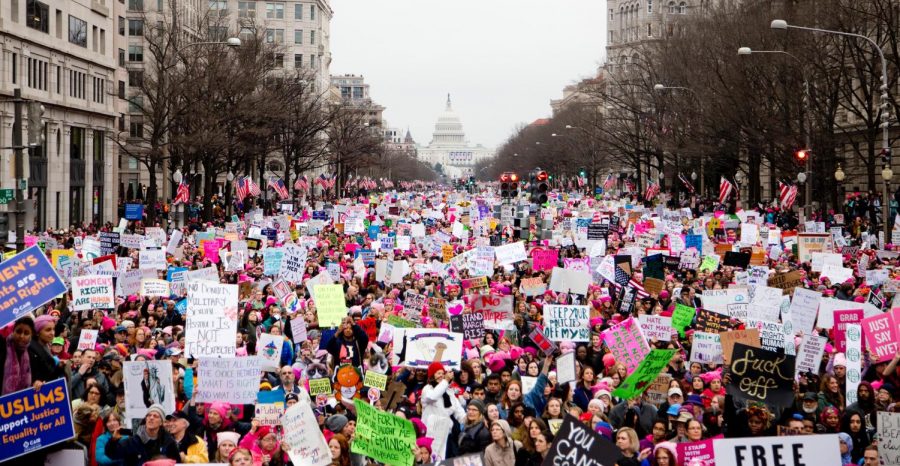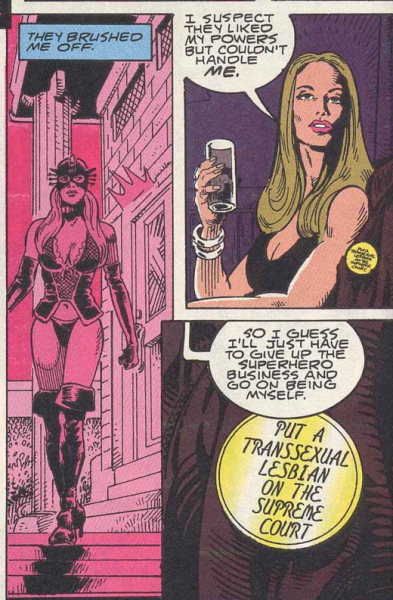An Intersectional Insight
The issues of inclusivity and intersectionality at the Women’s Marches.
Last week, the United States celebrated the first birthday of the nationwide gathering of pink pussy hats, cogent and commanding cries, and powerful protests signs. On January 21st, 2017, between 3.3 and 5.2 million people gathered at the Women’s March in protest after Donald Trump’s inauguration. With protest themes ranging from racial equality, immigration rights, reproductive rights, equal pay and much more, this symbol of solidarity was one of the largest single day marches held in U.S. history.
Despite the millions who stood outside on the winter day, marching in crowded streets with fists and signs raised high, many white and cisgender protesters tainted and ignored the original message of the march. The 2017 march may have served as a movement in protest against the national divisions sparked by our current president, however, it still managed to be very exclusive of many marginalized groups.
“I feel like the women’s march comes from a good place…but it’s just fundamentally built on a lot of white feminism and T.E.R.F. culture [trans exclusionary radical feminism] and that’s just something I don’t want to be a part of.” said junior Elli Lingappa, the co-president of Garfield’s Intersectional Feminist Club.
One of the most visibly exclusive aspects of the 2017 march was the isolation of transgender and non-binary people. With a plethora of pink pussy hats, “Pussy Grabs Back”, “U.S. Out of My Uterus” and “Viva la Vagina” protest signs, it was apparent that some cisgender people were equating having vaginas with womanhood. This thought isolates and erases the “authenticity” of transgender identities, as it creates a message that gender is primarily defined by genitalia. While cisgender women are allowed to show pride over their vaginas, it is a necessity to stray away from promoting a trans exclusionary form of feminism.
Additionally, the 2017 march failed to be inclusive of people of color (especially women of color) and their experiences as marginalized groups. Simply due the fact that there were white women present, the appearance of white feminism was sparked and was noticeable to many people of color.
“ Women failed to recognize that struggles for women’s rights are also struggles against homophobia, and transphobia, and racism, etc.” said Lingappa.
At the 2017 march, signs with “75 cents to a dollar” displayed how many protesters centered the problem around white women, failing to recognize the additional hurdles and inequities that women of color (WOC) face, with not only equal pay, but also in society as a whole. WOC were being silenced in a place when their voices should have been heard and amplified.
“Not giving a voice to people of color, not giving a space for people who are disabled to speak, not giving a space for people who may not speak English fluently or at all, things like that…it’s really irritating when those voices aren’t heard because those are most of the voices of the world, and white feminism is really only a small percentage of everything.” states sophomore Keya Abegaz, a student of color passionate about social justice and creating safe intersectional spaces.
Due to their actions, it can be assumed that some cis white women felt that protests against racism should not have been at a march primarily focused on women’s rights, reproductive rights, and equal pay. These actions tend to neglect the endeavors and discrimination of POC in general. However, protests against all forms of oppression should be welcomed, as all forms of discrimination are intertwined and overlapping. WOC have had difficulties with intersectionality in feminism and this march helped to bring that repressed issue back to light. While white women can face forms of oppression, in comparison, WOC ultimately are at a greater disadvantage in society within the U.S. This exclusion ultimately did not promote an intersectional form of feminism. Considering that WOC make up about 36% of the female population in the U.S., one would think they deserve more representation.
“Intersectionality means acknowledging how different systems of oppression…overlap with each other, especially in terms of identity… I feel there are a lot of people who aren’t willing to learn [this] and have their feminism critiqued.” said Lingappa.
Intersectionality affects a large portion of the population so creating spaces and marches that are inclusive, in my opinion, will allow more positive and successful progress or change.
“Not having intersectional spaces makes it so that I have to scream to be heard. Or I have to tell a white person to speak for me.” said Abegaz.
These issues with inclusivity in the 2017 march, were reflected in the January 20th, 2018 Women’s March. In the 2018 march, the transphobia, racism, and ableism still lingered in the air, however, many people were more conscious about intersectionality this year. Despite this awareness, pink pussy hats still dominated the streets. And although this march was lesser than that in 2017, it still gathered about 1 to 2 million people in major cities within the U.S.
“In general, creating such a mass protest, with a bunch of people who had really good intentions, and who care a lot, is really impressive!” said Lingappa.
Despite the aforementioned problems, steps can be taken to serve as an inclusive ally, when protesting or advocating for social justice or change.
“Being an ally, the best way in my opinion, would be to, like, if a Black person is trying to speak or trying to express something, either making everyone listen to them or…using you as a microphone, but not changing their words,” said Abegaz. “Giving them a space to speak…give people of color a voice to express themselves and to be able to tell their story the way that only they know how to.” said Abegaz.
In my opinion, in major marches or protests, privilege must be recognized by EVERY person/participant. When attending a protest from ANY position of power, such as being cisgender, white, male, straight, Christian, able bodied, etc., we need to understand that our life is not always the one thats in the most danger. Rather than always speaking our voice, at times, we need to listen to the cries of those in peril.





